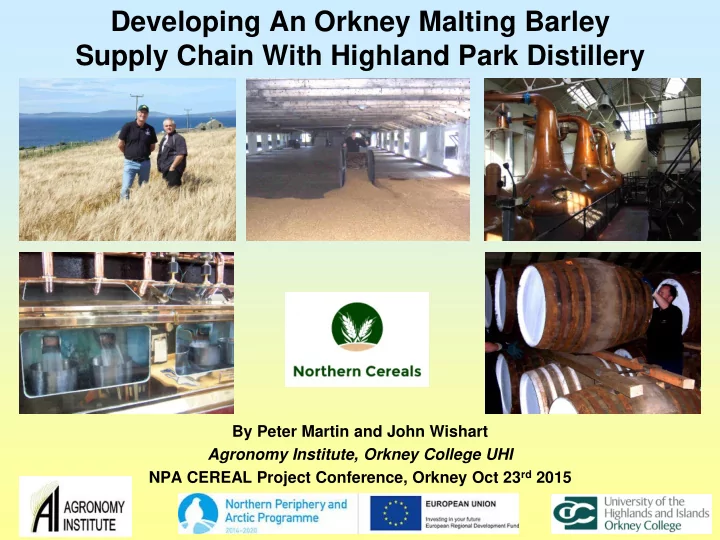

Developing An Orkney Malting Barley Supply Chain With Highland Park Distillery By Peter Martin and John Wishart Agronomy Institute, Orkney College UHI NPA CEREAL Project Conference, Orkney Oct 23 rd 2015
Introduction Presentation will describe: • A collaborative project between the AI, Highland Park Distillery and a small group of local growers to supply locally grown malting barley to develop an “All - Orkney” whisky Important background considerations to this project: • HP has retained its own malting floors o Local grain can be malted on site • No tradition of growing malting barley in Orkney: o Through the 20 th C, Orkney farmers concentrated on feed barley o Like all other Scottish distilleries HP sourced barley from the main southern suppliers • Orkney is about 100 miles further north than other the nearest commercial growers of malting barley: o Different soil and growing conditions
Collaboration Between AI & Highland Park Distillery Agronomy Institute. Opened at Orkney College in 2002. A major aim was to develop new markets for crops. Discussions with HP resulted, in 2009, in a feasibility project to investigate the growing of modern malting barley in Orkney with aim of producing an “All - Orkney” whisky. 2009 Research Trial: • 5 modern malting barley varieties selected by HP • Tested in a field trial by AI for yield, disease resistance, earliness • Grain samples tested for malting quality Main results: • Demonstrated that good quality malting barley could be grown successfully in Orkney • ‘Tartan’ selected as the best variety • From 2010, HP asked AI to develop a supply chain for producing Tartan
Supply Chain Outline Supply chain: • 4 growers + AI, each growing 2-2.5 ha of Tartan • Aim to produce 50 t grain annually for malting at HP AI role: • Co-ordinates supply chain • Provides guidelines to growers • Dries grain and delivers to HP: o Must have mc <=13% o Germination capacity not less than 98% • Collects and analyses data on production and grain quality • Feedback to growers & HP to improve future quality - open exchange of information. Has helped all improve knowledge of growing malting barley Grain supply contract with each grower: • A basic price/t at 15% mc with premiums and deductions • Premiums for grain N <1.65% dm • Deductions for i) grain N > 1.65% dm, ii) mc at harvest >22%, iii) screenings > 10%
Supply Chain Performance
Grain Yield And Grain Nitrogen Grower payments mainly determined by grain yield and grain nitrogen (premium or deduction) But, in several years, grain nitrogen and grain yield have been correlated with each other: • High yields associated with high grain N • Low yields associated with low grain N Analysis of supply chain data has shown that with the current grain supply contract, growers payments are highest if they achieve just below 1.65% grain N: • Do not aim for max yield – risks high grain N and price penalty • Do not target very low grain N – price does not compensate for yield loss Grain nitrogen is affected by: 1. The amount of nitrogen fertiliser applied, 2. The amount of available soil nitrogen (ASN). On heavier soils, especially, care is needed not to apply too much fertiliser N and obtain high grain N. Less of a risk on sandy soils. ASN is highest in the first years after a field comes out of grass but then decreases as the years of arable cropping increase. • Can be difficult to achieve low grain N in fields newly out of grass. For low grain N, it may be easiest to use fields which have been at least 2-3 years in arable cropping
Maintaining ‘Tartan’ Seed of ‘Tartan’ ceased to be available from 2013. Since then each grower has maintained his own line as farm-saved seed. Care is needed to maintain its purity. • Need a clear demarcation between ‘Tartan’ and any other variety. • Need for roguing to remove volunteers • Important that machinery is cleaned of seed of other varieties before planting, combining and drying. • Beware of Bere! Each year ca 0.5 t of grain from each farmer’s batch of Tartan is held back and sent to McCreath, Simpson & Prentice for safe storage, cleaning and dressing before it is returned as seed A reserve of 0.5 t of grain from each farmer is held at MSP in case of crop failure.
Summary Of Benefits Long-term collaboration between HP, the AI and local growers has yielded several mutual benefits: • HP has obtained a supply of locally grown modern malting barley allowing it to lay down an annual stock of spirit for a future release of a very high value “All - Orkney” single malt whisky. • Orkney growers and the AI have obtained a new source of income • Benefits also trickle down to others in the agricultural sector (especially contractors) • A new commercial crop (malting barley) has been introduced to Orkney – the most northerly modern malting barley grown in Scotland.
Acknowledgements Funding Support • The HI Links programme contributed funding towards the initial feasibility project.
Recommend
More recommend